Michael Portillo – From political hate figure to cuddly presenter
Wednesday, April 24, 2024
By Paul Whitelock
24 April 2024
 In the UK General Election of 1997, I well remember the TV coverage of the result in the Enfield Southgate constituency in the 1997 general election, at around 3:10am on 2 May 1997. The Labour Party candidate Stephen Twigg defeated the sitting MP, Defence Secretary in the Thatcher and Major governments, Michael Portillo. The thunderous look on Portillo’s face was wonderful to behold. Had there ever been such an obnoxious politician? In the UK General Election of 1997, I well remember the TV coverage of the result in the Enfield Southgate constituency in the 1997 general election, at around 3:10am on 2 May 1997. The Labour Party candidate Stephen Twigg defeated the sitting MP, Defence Secretary in the Thatcher and Major governments, Michael Portillo. The thunderous look on Portillo’s face was wonderful to behold. Had there ever been such an obnoxious politician?
Introduction
From villain to saint, from zero to hero; has there ever been such a dramatic conversion in the history of mankind? Saul to Paul on the Road to Damascus comes close, I guess.
 Michael Portillo, the epitome of a right-wing nasty politician, this son of a Spanish republican in exile from his homeland and a Scottish mother, has transformed himself into a well-liked travel presenter and occasional benign political commentator. Michael Portillo, the epitome of a right-wing nasty politician, this son of a Spanish republican in exile from his homeland and a Scottish mother, has transformed himself into a well-liked travel presenter and occasional benign political commentator.
Nowadays Miguel Portillo lives in Carmona near Sevilla in Andalucía. He is a fluent Spanish speaker and has returned to live in the country of his father’s birth.
The politician
Michael Denzil Xavier Portillo, known on his passport as Miguel Portillo y Blyth, was born in Bushy, Hertfordshire, in 1953 (currently aged 70) and was first elected to the House of Commons as an MP in 1984
He became Chief Secretary to the Treasury under Margaret Thatcher and subsequently Employment Secretary. He was Defence Secretary in John Major’s government following the demise of “The Iron Lady”.
He was forthright and controversial and not popular, but he was a Tory in a safe seat, the Enfield Southgate constituency. Until 1997 when he and most of the nation were “gobsmacked” when he was ousted by Labour candidate Stephen Twigg. Nobody saw that coming.
The “train guy”
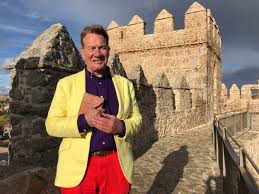 He got a gig as the presenter of a travel programme using the train network, first in the UK and then abroad. There is a memorable programme where he travels on the Al Andalus Express and calls in on Ronda, the town where I have lived for over 15 years. He got a gig as the presenter of a travel programme using the train network, first in the UK and then abroad. There is a memorable programme where he travels on the Al Andalus Express and calls in on Ronda, the town where I have lived for over 15 years.
He has now moved on to be host of a new TV programme called 'Andalucía con Michael Portillo', a production by AMC Networks International in which he tours southern Spain, now his home.
The “old” life
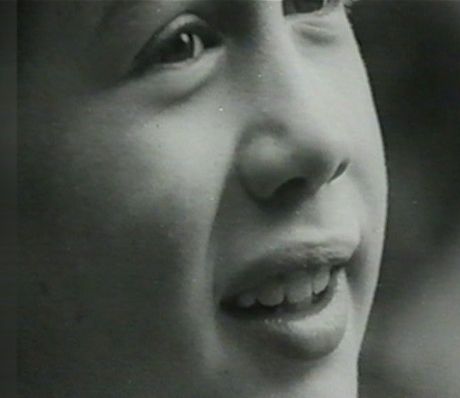 After starring, at the age of six, in a TV commercial for the drink Ribena, Michael Portillo obtained a first class degree in history from the University of Cambridge. He began his working life as a graduate trainee with the transport company Ocean Group plc, before joining the Conservative Research Department in 1976. After starring, at the age of six, in a TV commercial for the drink Ribena, Michael Portillo obtained a first class degree in history from the University of Cambridge. He began his working life as a graduate trainee with the transport company Ocean Group plc, before joining the Conservative Research Department in 1976.
First elected to the House of Commons in 1984, Portillo served as a junior minister under both Margaret Thatcher and John Major, before entering the Cabinet in 1992 as Chief Secretary to the Treasury.
He was promoted to Secretary of State for Employment in 1994.
A Thatcherite and a Eurosceptic, he was seen as a likely challenger to Major during the 1995 Conservative Leadership election, but did not stand, and, as a reward, was subsequently promoted to Secretary of State for Defence.
Portillo unexpectedly lost the hitherto safe Conservative Enfield Southgate seat at the 1997 general election. This led to the coining of the expression "Portillo moment".
Returning to the Commons in the 1999 by-election in Kensington and Chelsea, Portillo rejoined the frontbench as Shadow Chancellor of the Exchequer.
Standing for the leadership of the party in 2001, he came third behind Iain Duncan Smith and Kenneth Clarke.
He retired from the House of Commons and from active politics at the 2005 general election.
His membership of the Conservative Party has since lapsed.
His high profile led to constant attention from the media, including Private Eye, which mockingly referred to him as "Portaloo".
A New Life
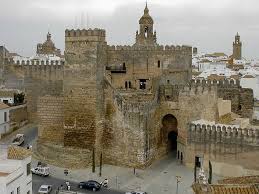 Now living in Carmona, near Sevilla, Portillo has fashioned a new life. He is a well-respected travel presenter. In an interview given to journalist Rosa Palo of Diario Sur, published on Sunday 21 April 2024, he talks of his two lives, first as a politician and then as a TV presenter. Now living in Carmona, near Sevilla, Portillo has fashioned a new life. He is a well-respected travel presenter. In an interview given to journalist Rosa Palo of Diario Sur, published on Sunday 21 April 2024, he talks of his two lives, first as a politician and then as a TV presenter.
He reminisces about his father, Luis Gabriel Portillo, a republican politician in Spain, who sought exile in the UK as Franco came to power in the 1939.
He also talks about his new television venture 'Andalucía con Michael Portillo', a production for Spanish TV in which he tours southern Spain.
Fluent in Spanish he now lives in Carmona and enjoys his time with local friends. He plans to stay put when he retires.
“Me encanta la vida que tengo y no puedo pensar en variarla,” he says in his perfect Spanish. (I love the life I have and cannot imagine changing it).
© Paul Whitelock
Acknowledgements:
A1 Translations
Diario Sur
Rosa Palo
Wikipedia
Tags:
1997 general election, A1 Translations, Andalucia, 'Andalucía con Michael Portillo’, Cambridge, Carmona, Chief Secretary to the Treasury, Commons, Diario Sur, Enfield Southgate, Eurosceptic, House of Commons, John Major, Kensington and Chelsea, Luis Portillo, Margaret Thatcher, Michael Portillo, Ocean Group plc, Paul Whitelock, Peterhouse, “Portaloo” "Portillo moment", Private Eye, Ribena, Ronda, Rosa Palo, Secretary of State for Defence, Secretary of State for Employment, Stephen Twigg, Thatcherite, “The Iron Lady”, Wikipedia
 0
Like
Published at 6:33 PM Comments (0)
0
Like
Published at 6:33 PM Comments (0)
Montejaque “gets the bird” (festival)
Tuesday, April 23, 2024
By Paul Whitelock
Tuesday 23 April 2024
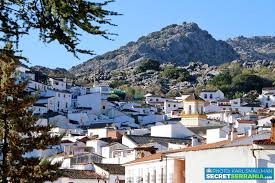 For the first time the small village of Montejaque (Málaga – pop. 980) has played host to the Andalucia Bird Festival. For the first time the small village of Montejaque (Málaga – pop. 980) has played host to the Andalucia Bird Festival.
Over the course of three days last weekend, the festival offered talks, walks and so much more in the Centro de Deportes of this village in the Serrania de Ronda on the edge of the Sierra de Grazalema.
This area is on the migration route of hundreds of bird species, many of them quite rare.
Pre-amble
With wide coverage in the local, regional and national press, the organisers, including Englishman Peter Jones, president of the Andalucia Birdwatching Society, and long-time resident of the area, were delighted.
Here are some translated extracts from Ronda-based journalist Vanessa Melgar’s recent article In regional newspaper SUR. Vanessa also writes for local newspaper Ronda Semanal.
Andalucía Bird Festival 2024
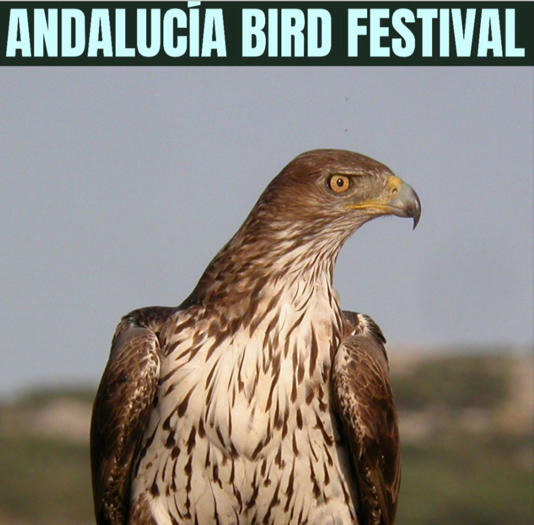 Montejaque was the epicentre of ornithology this past weekend. This small town in the Guadiaro valley, in the Serranía de Ronda, is one of the best places for birdwatching, an activity with an increasing number of enthusiasts, both nationally and internationally. Montejaque was the epicentre of ornithology this past weekend. This small town in the Guadiaro valley, in the Serranía de Ronda, is one of the best places for birdwatching, an activity with an increasing number of enthusiasts, both nationally and internationally.
Montejaque celebrated for the first time its Andalucía Bird Festival and hopes it will become a regular feature and a benchmark of this important sector.
Friday 19 April
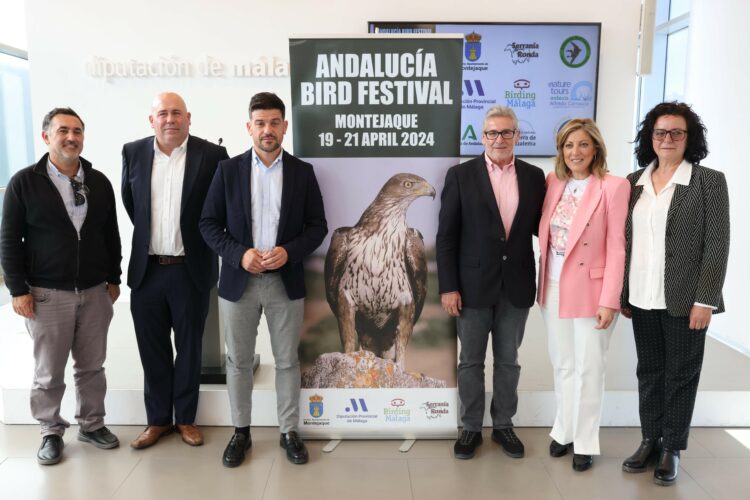 On Friday, the festival was inaugurated by Patricia Navarro, the delegate of the Andalusian Government in Málaga; José Antonio Víquez, the delegate for the Environment; Cristóbal Ortega and María del Carmen Martínez, the provincial deputies for the Environment and Economy respectively; and Diego Sánchez, the mayor of Montejaque. Also present were, among others, Alfredo Carrasco, a specialist ornithology guide and head of the company Nature Tours Andalucía and the afore-mentioned Peter Jones, both heavily involved in the organisation of this event. On Friday, the festival was inaugurated by Patricia Navarro, the delegate of the Andalusian Government in Málaga; José Antonio Víquez, the delegate for the Environment; Cristóbal Ortega and María del Carmen Martínez, the provincial deputies for the Environment and Economy respectively; and Diego Sánchez, the mayor of Montejaque. Also present were, among others, Alfredo Carrasco, a specialist ornithology guide and head of the company Nature Tours Andalucía and the afore-mentioned Peter Jones, both heavily involved in the organisation of this event.
The festival ran for three days until last Sunday. The dates were chosen to coincide with the migratory passage of birds from Europe to Africa, flying over Montejaque and the Serranía de Ronda to the Strait of Gibraltar.
The festival comprised a range of activities including conferences, exhibitions, workshops, ringing birds, making nest boxes and field trips.
"The conservation of natural heritage is in itself a gold mine of development and the fight against depopulation," said Navarro, while highlighting the need to support ornithological tourism.
"It is an activity that has aroused great interest in the last two decades with a type of visitor aware of nature conservation.”
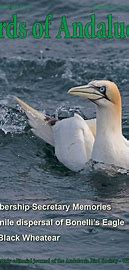 In the province of Málaga you can observe around 300 species of birds, an attraction that attracts hundreds of tourists, especially foreigners mainly British, with an average age of 50 years, also interested in the flora and the rest of the fauna in general. In the province of Málaga you can observe around 300 species of birds, an attraction that attracts hundreds of tourists, especially foreigners mainly British, with an average age of 50 years, also interested in the flora and the rest of the fauna in general.
The best times to enjoy this activity are autumn and spring. The most common species are vultures and flamingoes. The province also has wetlands that are nesting points.
In and around Montejaque it is possible to see the wheatear, the crested lark, the stonechat, the booted eagle and also the rare and much sought-after Bonelli's eagle.
Saturday 20 April
On Day 2 of the festival, Saturday, the programme started with a route, which allowed observation of birds in the surroundings of El Pantanillo and concluded in the evening with another walk in the surroundings of the Cueva del Hundidero and the Presa de los Caballeros.
There were also presentations by Jacinto Segura, Stewart Finlayson, Keith Bensusan, Antonio Román-Muñoz and Jesús Pinilla. There was also a children's workshop of crafts, drawings and face-painting.
Sunday 21 April
On Sunday, the event continued with a bird-ringing workshop in the morning and another route through the area of the Cueva del Hundidero and the Presa de los Caballeros; a children's workshop on making nest boxes; the award ceremony of a photography contest and discussions led by Tim Appleton, director of the Global Bird Fair-UK; Miguel González and Eva Bratek, herself a former resident of Montejaque. After that the documentary film Aguilucha: The Indomitable Spirit was presented.
The Festival concluded with another observation walk through El Pantanillo.
Conclusion
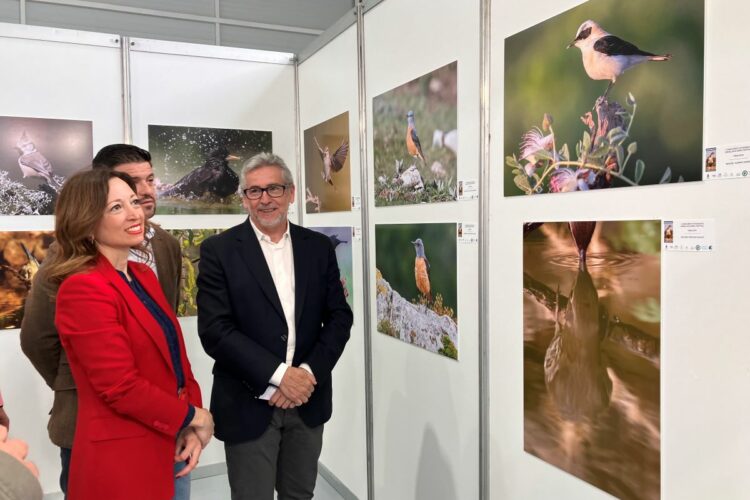 As a resident of Montejaque for many years, I commend mayor Diego Sánchez and his team, for their efforts in boosting the tourism profile of the town. As a resident of Montejaque for many years, I commend mayor Diego Sánchez and his team, for their efforts in boosting the tourism profile of the town.
This festival is just one of the many projects which have been introduced over the years to enhance the offer. Two new car parks, the Mirador, the Caminito and the current project to turn the abandoned Guardia Civil barracks into a hostal for walkers are just some of the steps that have been taken.
Montejaque looks forward to hosting the second Andalucia Bird Festival in 2025.
A round of applause to Peter Jones and Alfredo Carrasco for their enthusiasm and involvement in this inaugural event; to the regional politicians for their support; as well as to guests Tim Appleton, Miguel González and Eva Bratek for their contributions.
© Paul Whitelock 2024
Acknowledgements:
Alfredo Carrasco
Andalucia Birdwatching Society
Ayuntamiento de Montejaque
Diario Sur
Karl Smallman (main photo)
Peter Jones
Vanessa Melgar
Wikipedia
www.andalucialive.com (photo)
Further reading:
Birds of Andalucia (quarterly magazine published by the Andalucia Bird Society)
El Sistema Hundidero-Gato by Manu Guerrero Sanchez [Editorial La Serrania]
Las aves de la Serrania de Ronda [Editorial La Serrania]
Sierra de Grazalema (Map and Guidebook) [Editorial Penibética]
The Cookbook and Village Guide (El Libro de Cocina y Guia del Pueblo) by Carolyn Emmett [self-published]
Valle del Guadiaro by Manuel Becerra Parra [Editorial La Serrania]
Walking in Andalucia by Guy Hunter-Watts [Cicerone Press]
Walking in the Ronda Mountains by Tony Bishop and Eva Bratek [Editorial La Serrania]
Tags:
Aguilucha: The Indomitable Spirit, Alfredo Carrasco, Andalucia Bird Festival, Andalucia Birdwatching Society, Antonio Román-Muñoz, award ceremony, Ayuntamiento de Montejaque, Caminito, Carolyn Emmett, children's workshop, Cicerone Press, Cueva del Hundidero, Diario Sur, Diego Sánchez, Editorial La Serrania, Editorial Penibética, El Libro de Cocina y Guia del Pueblo, El Pantanillo, El Sistema Hundidero-Gato, Eva Bratek, Global Bird Fair-UK, Guardia Civil barracks, Guy Hunter-Watts, Jacinto Segura, Jesús Pinilla, Keith Bensusan, Las aves de la Serrania de Ronda, Manuel Becerra Parra, Manu Guerrero Sánchez, Miguel González, Mirador, Montejaque, nest boxes, ornithology, Paul Whitelock, Peter Jones, photography contest, Presa de los Caballeros, Ronda Semanal, Sierra de Grazalema, Stewart Finlayson, SUR, The Cookbook and Village Guide, Tim Appleton, Tony Bishop, Valle del Guadiaro, Vanessa Melgar, Walking in Andalucia, Walking in the Ronda Mountains, Wikipedia
 0
Like
Published at 10:29 AM Comments (0)
0
Like
Published at 10:29 AM Comments (0)
ST GEORGE’S DAY – APRIL 23
Tuesday, April 23, 2024
By The Crazy Guy
.jpg) St George, a military saint, is famous for slaying a fierce dragon, which was causing panic in the city of Silene, Libya, at the time that George arrived there. Historically, the countries of England, Bosnia and Herzegovina, Georgia, Ukraine, Malta, Ethiopia, as well as the regions of Catalonia and Aragon in Spain, and Moscow, the capital of Russia, have claimed George as their patron saint. St George, a military saint, is famous for slaying a fierce dragon, which was causing panic in the city of Silene, Libya, at the time that George arrived there. Historically, the countries of England, Bosnia and Herzegovina, Georgia, Ukraine, Malta, Ethiopia, as well as the regions of Catalonia and Aragon in Spain, and Moscow, the capital of Russia, have claimed George as their patron saint.
"My" St George
St George is also the nickname I’ve given to my builder, and now good friend, Jorge. This 51-year-old gallego, born in the same town, El Ferrol, as the infamous Spanish dictator Franco, who ruled over Spain for 36 years, following the Spanish Civil War, first entered my life in 2020.
I’ve used a few builders in my time, both in the UK and in Spain, but they’ve usually disappointed. Not Jorge. He is outstanding in every respect.
When he first showed up in Summer 2020 to dig me a ditch, I thought this quiet little man with the goatee beard was just a peón (labourer). He didn’t say much, just got on with the job and did it to my satisfaction.
I asked whether he could paint all my iron gates and fences. He did that conscientiously over the next few days, rubbing the metal down properly and wire-brushing the rusty bits before applying Hammerite.
I asked if he could lay bricks and render and finish off with capa fina so you couldn’t see the join.
“¡Soy albañil, coño!” was his slightly miffed reply.
Did he like gardening? Over that post-Covid period he has felled and pruned trees, built raised beds, constructed a superb jardinera on our private terrace and moved two cubas of topsoil from where it was dropped on the road outside my house into the garden to improve my very clay-y soil.
Electrical work? He installed an exterior socket for me in no time at all. At the house I am renovating in Montejaque he cut all the channels in the walls and ceilings for the re-wire and installed the cajetines, sockets and switches.
He has knocked down walls, built walls, replaced the rotten wooden beams in the kitchen ceiling with concrete ones, without the room above collapsing on top of us.
He re-did two roofs.
He doesn’t like carpentry, but he has hung new doors and installed windows. They’re perfect.
He even changed the wheel on my car when I had a puncture, something he had never done in his life.
What he doesn’t like is water. He won’t do plumbing, so José, my other albañil, or I do that.
In fact, he hates water so much, he left damp and rainy Galicia at the age of 17 to come and join the Spanish Foreign Legion in Ronda, looking for a better climate.
After his 15 years’ service as a legionario, he stayed in the area, re-trained as a chef and later as an albañil (bricklayer).
Jorge has told others that I am his guiri friend, which makes me feel good, because I like him a lot too.
He even used to baby-sit my dog, Berti, on occasion, including overnight. Berti was sadly run over and killed. The guy truly is a saint.
He is quite fiery and very opinionated. He is well-informed and has, as far as he is concerned, valid views about what he sees as the disastrous politics of Spain. He is a huge fan of his hometown “brother”, Francisco Franco. As a confirmed liberal democrat/socialist, I disagree with him entirely, of course. As a point of fact, Spain has one of the fastest-growing economies in the world, right now.
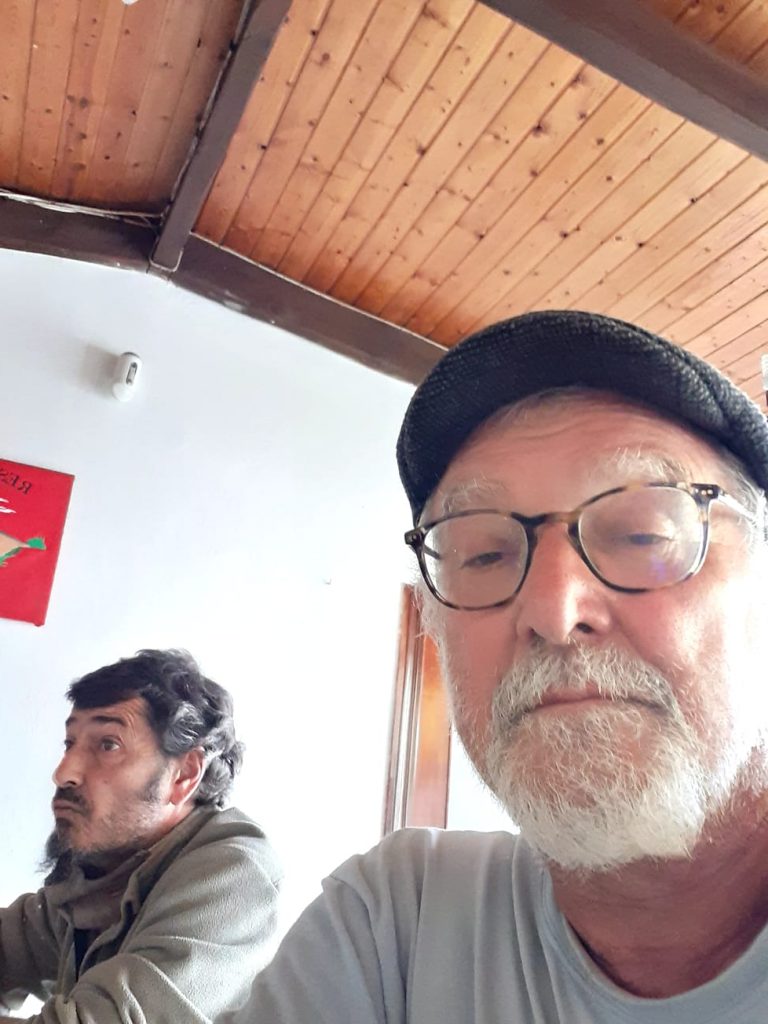
The saints George and Paul having a drink after work
As for my reforma, if he disagrees with what I want to do, he says so. The guy has style. He has come up with some much better ideas and solutions to problems than I have.
I’m the boss, as I pay the bills, but he’s the jefe really.
Jorge does not drive, so I have to collect him and take him home. He doesn’t like my driving.
“He sobrevivido cinco guerras; no quiero morir en un accidente de tráfico. Más despacio, coño, porfa.”
“I’ve fought in five wars (the Gulf – twice, Afghanistan, the Balkans and Iraq) and I’ve survived. I don’t want to die in a banal road accident. Will you please slow down.”
Fair enough. That’s San Jorge.
He no longer works for me as he has found permanent employment with a building company, and my obra is done, so I don’t need him. We occasionally bump into each other at my local and we have a good chinwag, avoiding politics, of course!
Note: The real St George, patron saint of England, and Spain’s dragon slayer, also have stories behind their legends. I just thought my St George is a more interesting character and, if you want to find out about him, you can’t look him up on Wikipedia.
© The Crazy Guy
Acknowledgements:
Karl Smallman
Paul Whitelock
Secret Serrania
Wikipedia
Tags:
Afghanistan, albañil, April 23, Aragón, Balkans, Berti, Bosnia and Herzegovina, carpentry, Catalonia, chef, Crazy Guy, cuba, electrical work, El Ferrol, England, Ethiopia, Foreign Legion, Francisco Franco, Franco, Galicia, gallego, George, Georgia, guiri, Gulf, Hammerite, Iraq, jardinera, Jorge, José, Karl Smallman, labourer, legionario, liberal democrat, Libya, Malta, Montejaque, Moscow, Paul Whitelock, peón, Ronda, St George, St George’s Day, San Jorge, Secret Serrania, Silene, socialist, Spain, Spanish Civil War, Spanish Foreign Legion
 2
Like
Published at 7:07 AM Comments (0)
2
Like
Published at 7:07 AM Comments (0)
My temporary office
Sunday, April 7, 2024
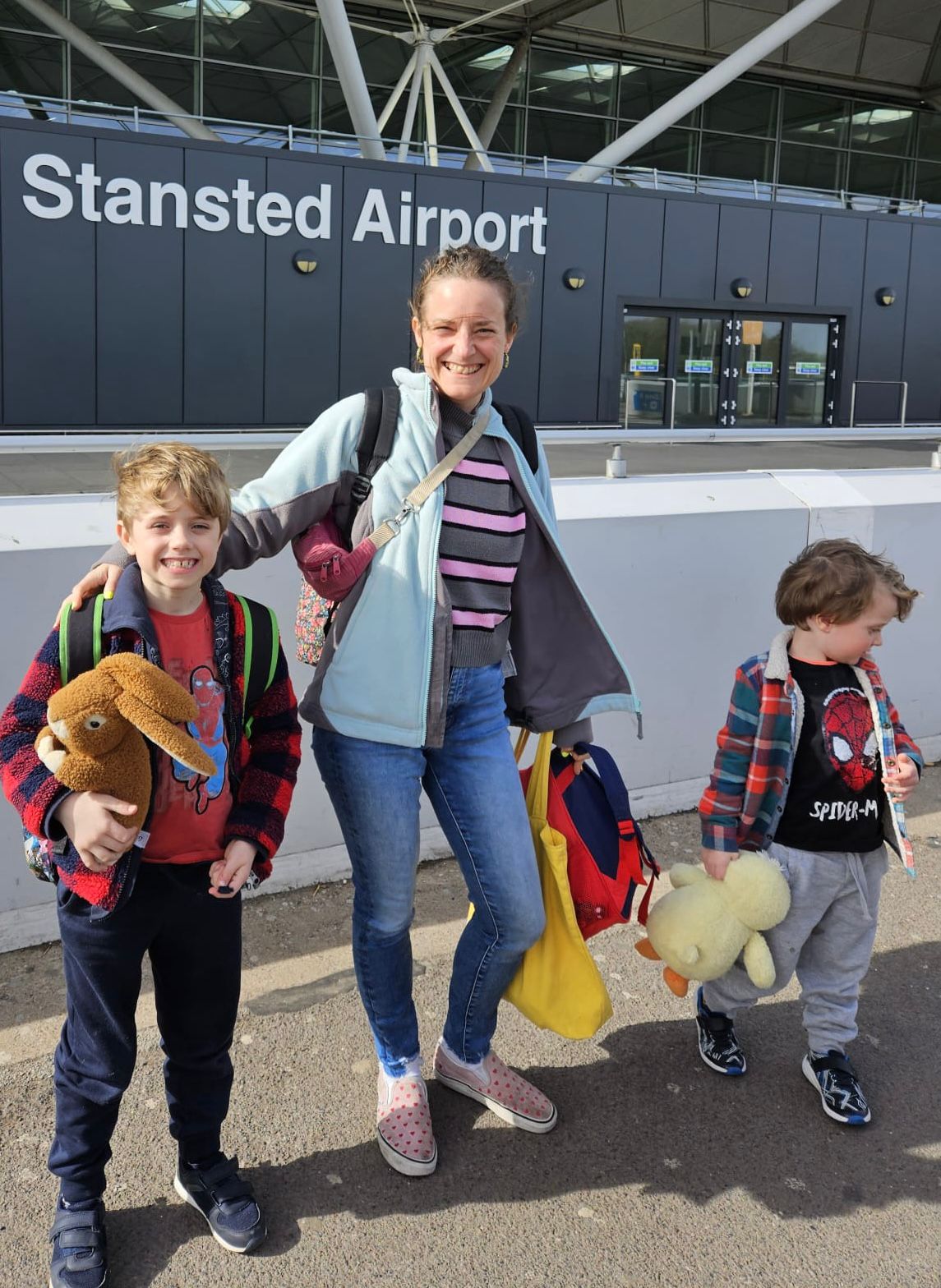 My daughter and two grandsons arrived from England late last night to spend a week with us here in Ronda. My daughter and two grandsons arrived from England late last night to spend a week with us here in Ronda.
Amy, Felix and Jude flew from Stansted to Malaga, where I picked them up.
We had spent the last few days getting our house, garden and pool tidied up ready for their arrival.
Photo : Jeryl Whitelock-Burgess
Busy, busy
 I cleaned the pool and tried it out a few times (Brrr! Just 15C!). I tidied up the garden and the playground which two friends and I created a couple of years ago for our eight grandchildren to use when they visit. I also created a new “secret garden” (a private seating area with loungers and a sun umbrella) at the back of our large plot with fruit bushes, plants, and a barbecue. I cleaned the pool and tried it out a few times (Brrr! Just 15C!). I tidied up the garden and the playground which two friends and I created a couple of years ago for our eight grandchildren to use when they visit. I also created a new “secret garden” (a private seating area with loungers and a sun umbrella) at the back of our large plot with fruit bushes, plants, and a barbecue.
And I planted more fruit trees in the adjacent huerto to complete my orchard.
Photo: iStock
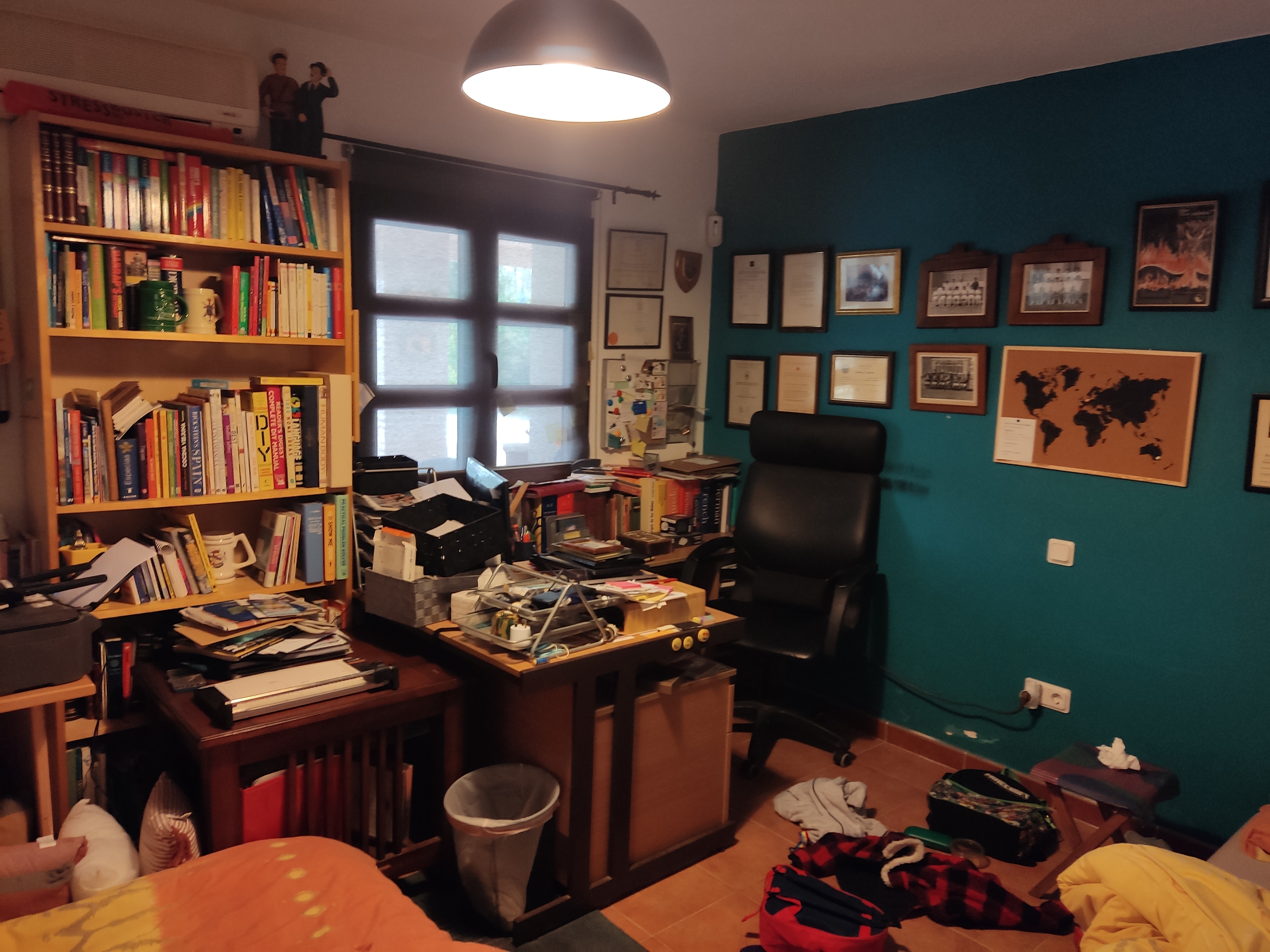 In the house I had to vacate the “office”, or study, which doubles as our third bedroom when we have visitors. Out came the two single beds for Felix and Jude, while Amy had the main guest bedroom to herself. In the house I had to vacate the “office”, or study, which doubles as our third bedroom when we have visitors. Out came the two single beds for Felix and Jude, while Amy had the main guest bedroom to herself.
So, I moved my computer to our “entrance lobby” off the dining room. It’s not used as an entrance as we blocked up the front door and use the back door as our main entrance.
My temporary office
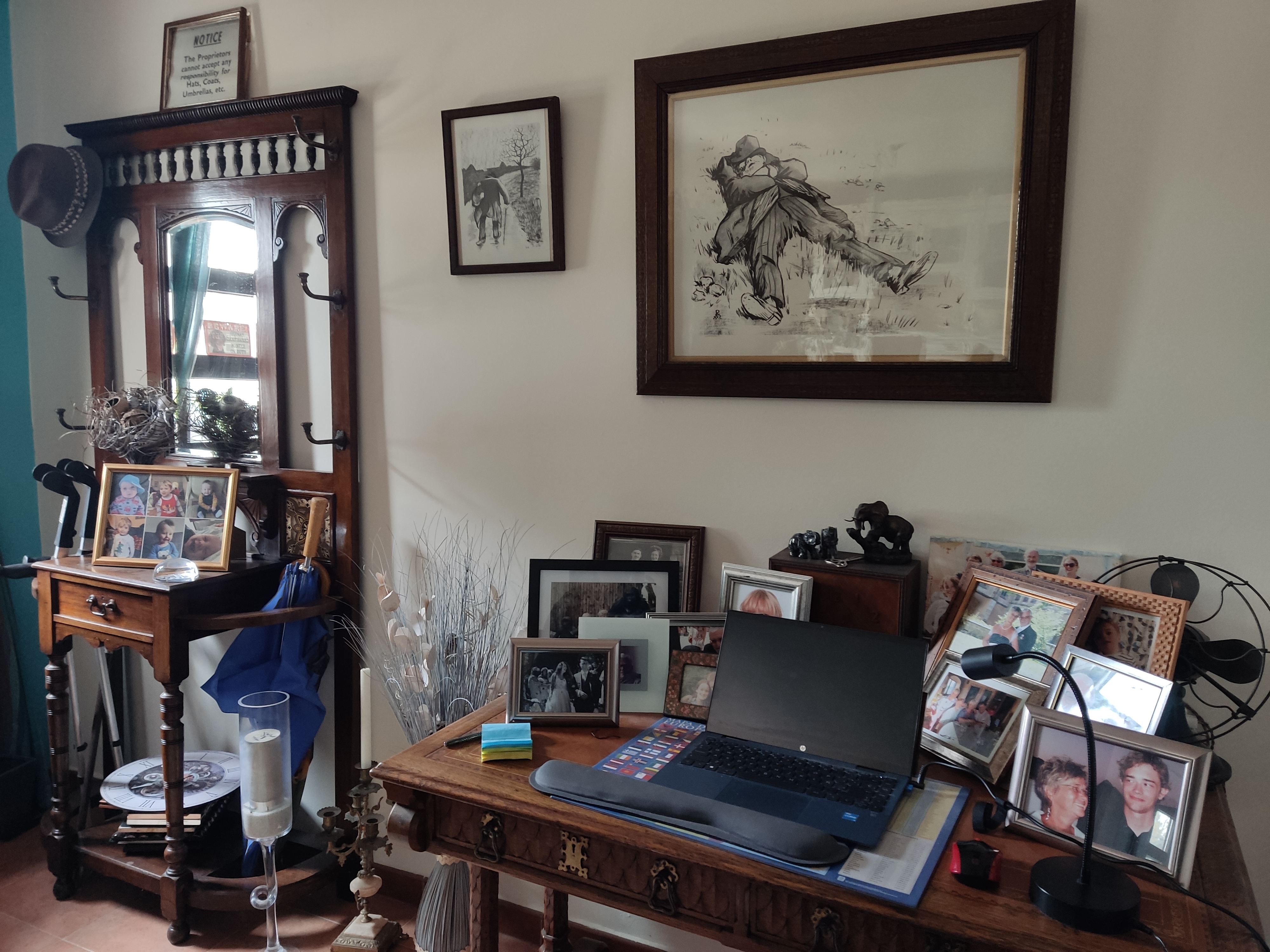 This “vestibule” is rather pleasant, if we say so ourselves. The furniture is antique. The restored desk is by Gillow and worth a lot of money. Crafted in the early 20th century before Mr Gillow got together with Mr Waring to establish an upmarket furniture chain in the UK, Waring and Gillow, sadly no longer. This “vestibule” is rather pleasant, if we say so ourselves. The furniture is antique. The restored desk is by Gillow and worth a lot of money. Crafted in the early 20th century before Mr Gillow got together with Mr Waring to establish an upmarket furniture chain in the UK, Waring and Gillow, sadly no longer.
That is where I am sitting writing this piece.
Pride of place on this piece of oak furniture with leather inlay is a pre-World-War-Two wooden clock on top of which sit three elephants from my extensive collection of said creatures. To the right is an antique desk-top fan, which works if needed, eg in the summer. The rest of the desk is covered with family photos which have been shoved to the back to make space for me to work.
Family photos
This is a true family archive spanning four generations. There are wedding photos of my mum and dad, Jack and Vera Whitelock (1948), of Rita and me (2010) and of Tom, my son, and Su (2018). Also, a wedding photograph featuring our extended family.
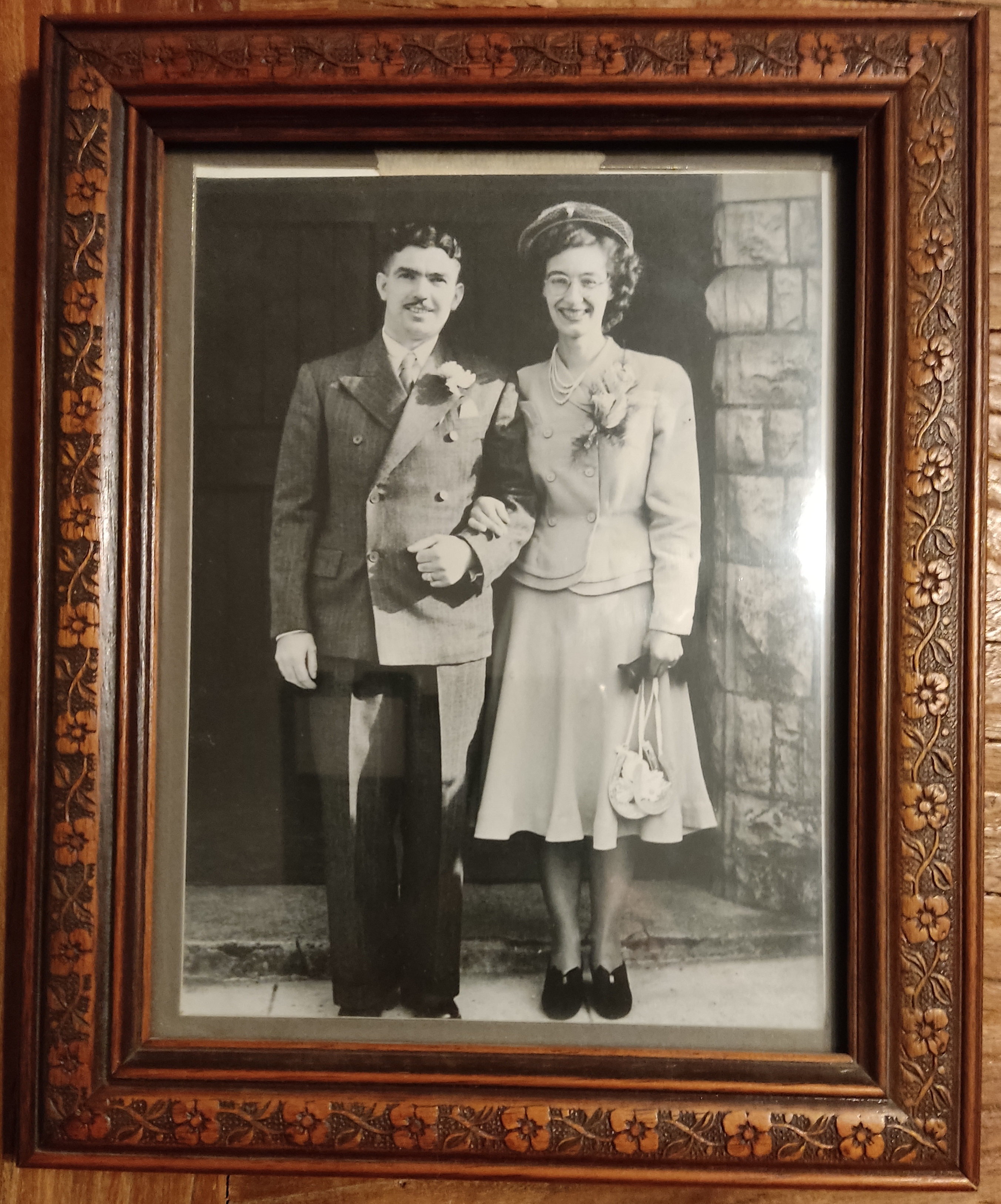 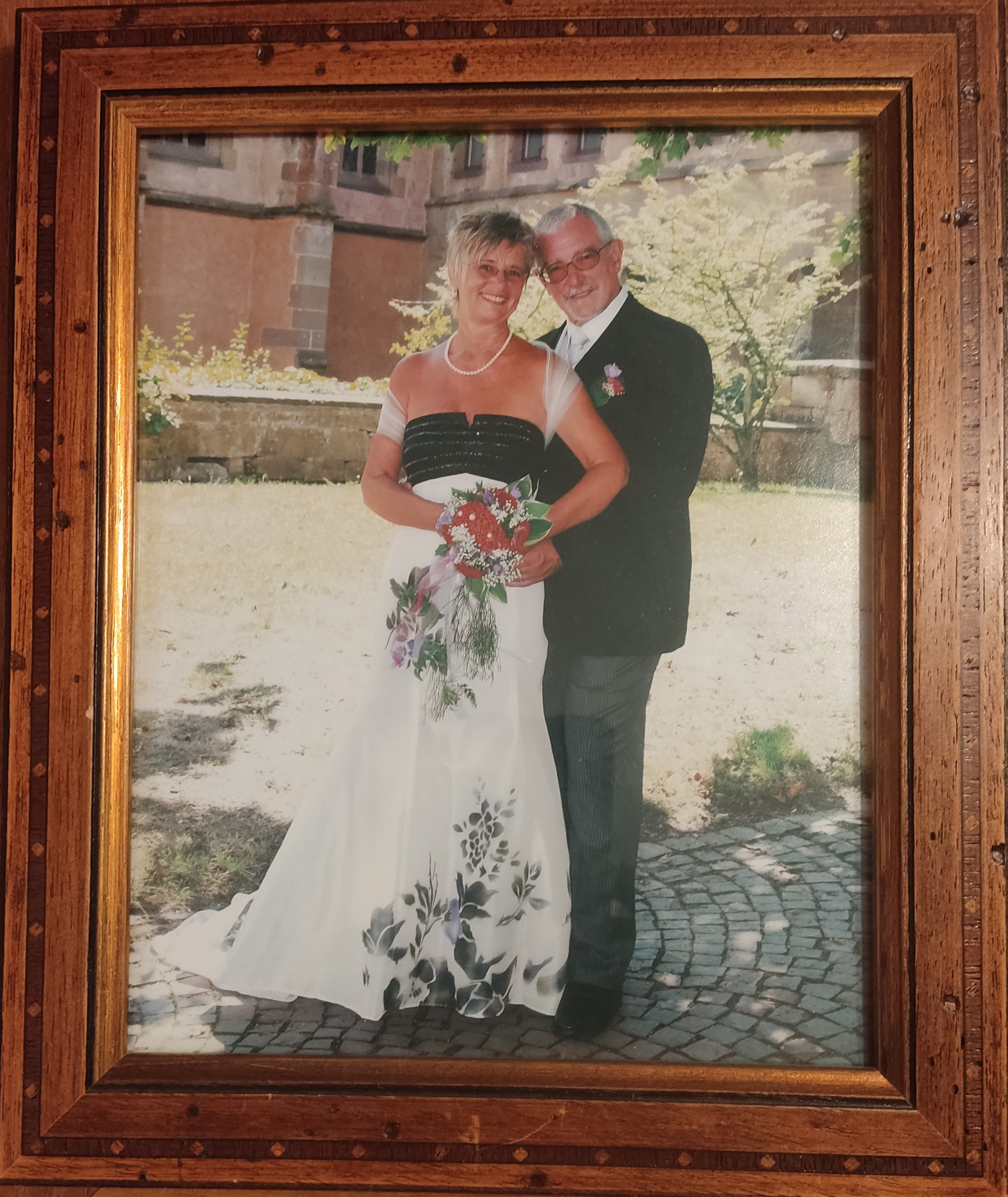 
Jack and Vera Whitelock (1948, UK) Rita and Paul Whitelock (2010, Germany) Su and Tom Austin-Whitelock (2018, UK)
There are old photos of the Drechslers, Rita’s family, with her mum Elisabeth, and four siblings (Rita is a cheeky-looking five-year-old), Birgid, Karin, Horst, and Irmhild. Missing from the photo is Friedrich, dad, who died when the children were small. Karin later died young, aged 26, following a botched routine hospital operation.
Also, a photo of Rita’s two surviving sisters, Birgid and Irmhild, and their husbands, Uwe and Egon.
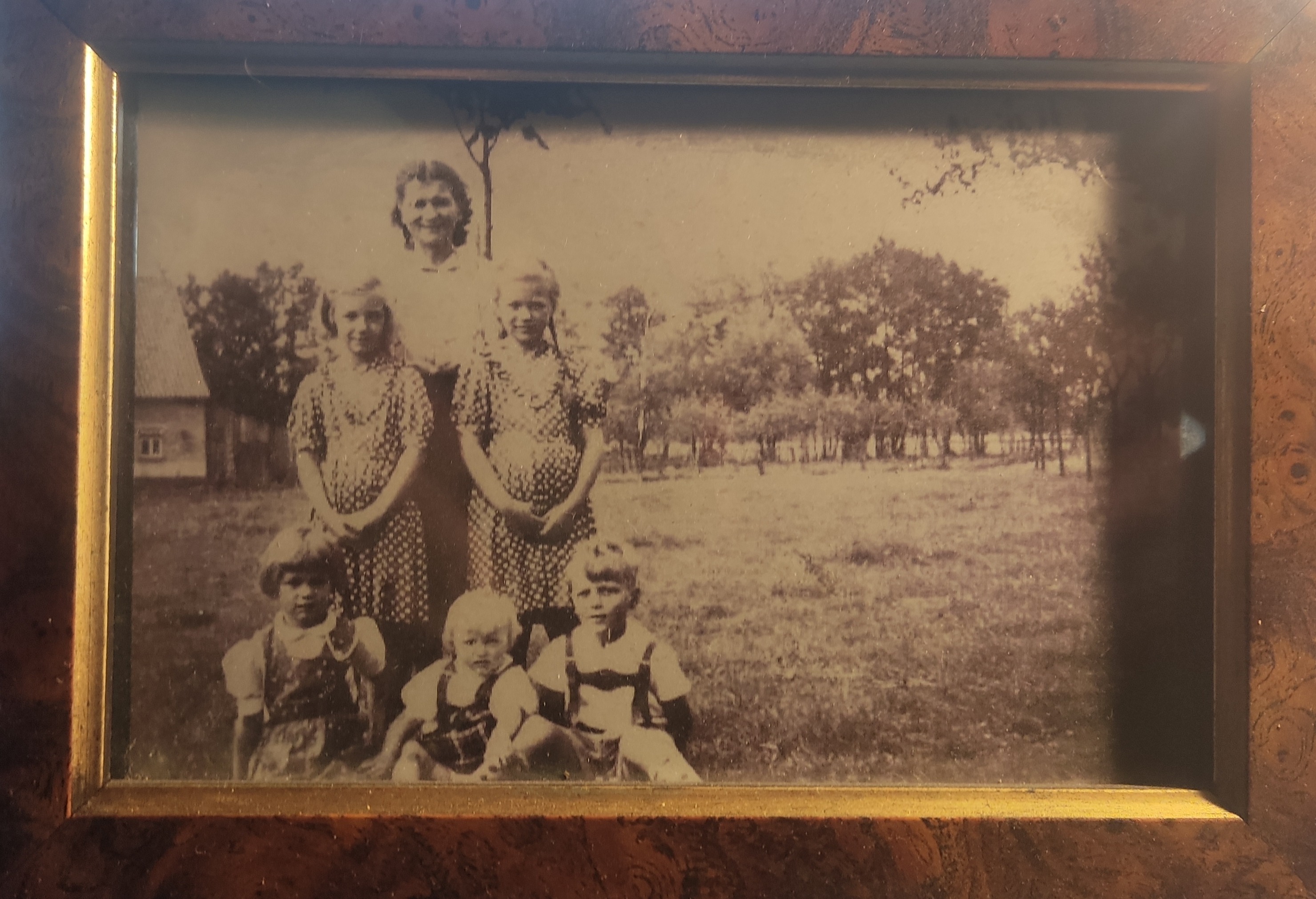 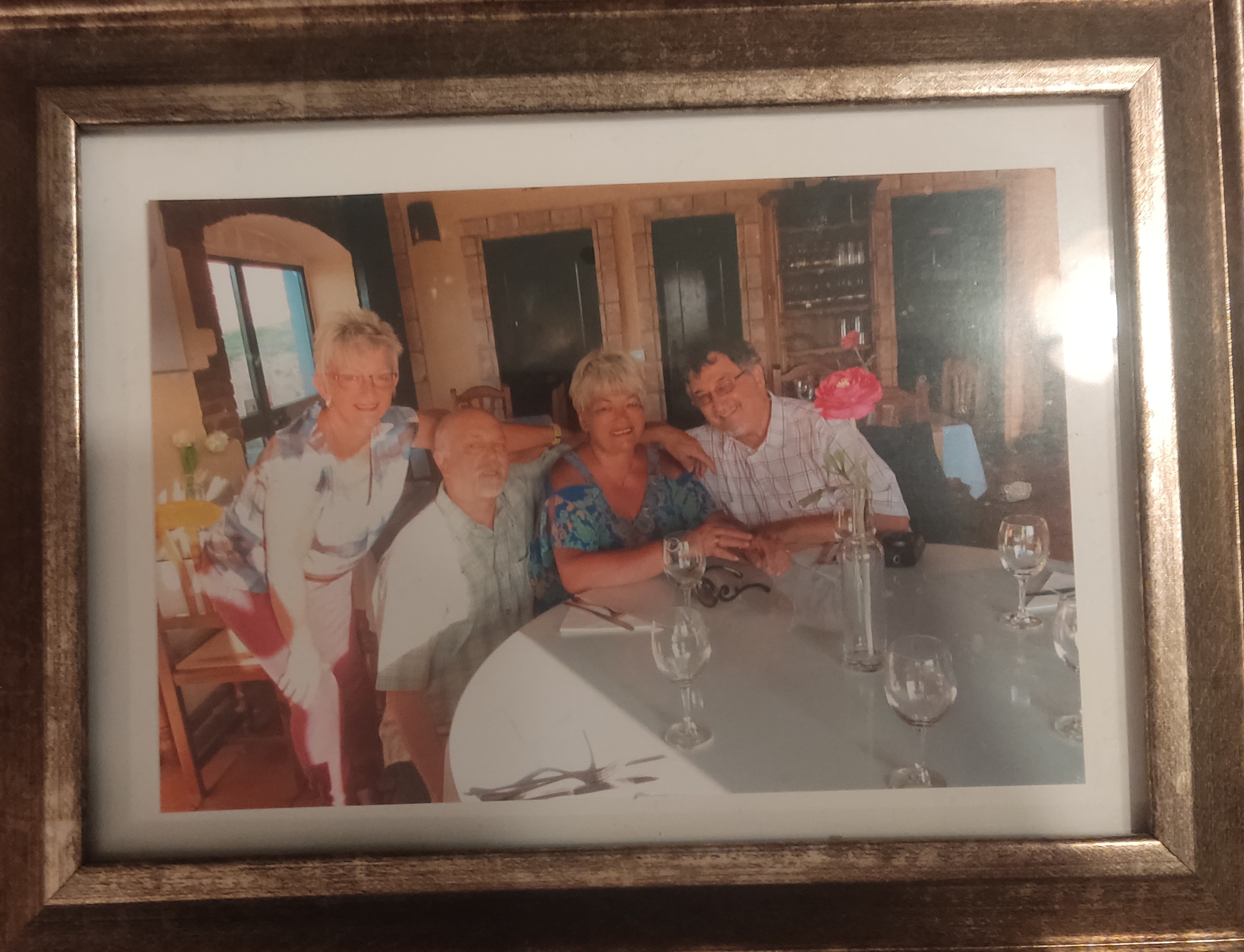
The Drechslers from Oesterholz (NRW) The Brinkmanns and the Goehmanns
On the desk is also a nice photo of Rita with younger son, Jojo (Jonathan).
.jpg) As for my side of the family, apart from the ones already mentioned, there’s a nice photo of me and my mum, Vera (then aged 92), taken outside Maulbronn Abbey where we got married. Yes, despite her age and being in a wheelchair, Vera made it to our wedding in Germany. As for my side of the family, apart from the ones already mentioned, there’s a nice photo of me and my mum, Vera (then aged 92), taken outside Maulbronn Abbey where we got married. Yes, despite her age and being in a wheelchair, Vera made it to our wedding in Germany.
There’s a photo of me and Rita taken at Restaurante Molino del Santo in Estacion de Benaojan, where we were celebrating a wedding anniversary; of Felix and Jude with a gorilla at Fuengirola Zoo; Felix’ first school photo and another photo of Felix and Jude; Amy and Tom as teenagers in our garden in Thelwall, Cheshire, and that’s it.
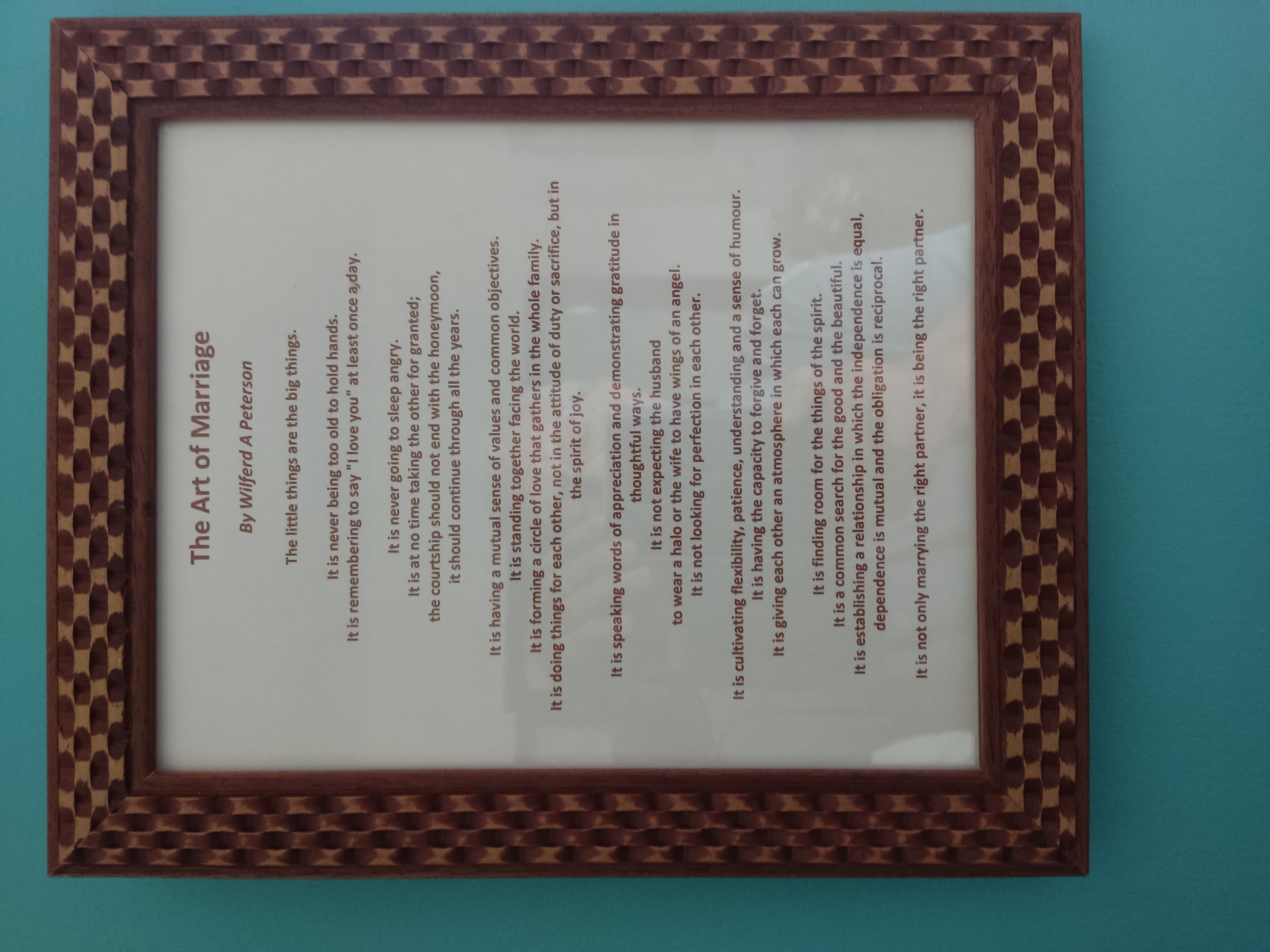
The rest of this lobby area features a restored wooden hallstand, a metre-high oak cakestand, an oak dining chair and a large painting on an easel, which I bought from Venta El Puente, La Indiana, where it was on display.
On the walls there are two pictures of tramps in old oak frames and a framed poem, called ‘The Art of Marriage’ by Wilferd A Peterson, which was read at our wedding by my best man, brother Simon.
As I sit here writing this, all is peaceful. It’s Saturday 7.30 am and the others are still asleep. I shall conclude this now and go and make a second cup of tea. I’m English and old habits die hard!
Have a good day!
PS. It’s my brother Simon’s 71st birthday today. Congratulations, bruv!
© Pablo de Ronda
Photos:
Paul Whitelock, unless labelled otherwise .
Tags:
Amy, Art of Marriage, barbecue, Birgid, Cheshire, Drechsler, Egon, Elisabeth, Estación de Benaoján, entrance lobby, Felix, fruit bushes, fruit trees, Fuengirola Zoo, garden, Gillow, Horst, huerto, Irmhild, Jack, Jojo, Jonathan, Jude, Karin, La Indiana, Maulbronn Abbey, Molino del Santo, oak furniture, office, orchard, Pablo de Ronda, plants, playground, pre-World War Two wooden clock, Rita, Ronda, secret garden, Simon, study, Su, temporary office, Thelwall, Tom, Uwe, Venta El Puente, Vera, vestibule, Waring, Waring and Gillow, Whitelock, Wilferd A Peterson
 1
Like
Published at 8:24 AM Comments (0)
1
Like
Published at 8:24 AM Comments (0)
“The Good Life” (Andalusian style)
Thursday, April 4, 2024
 Do you remember the classic BBC Television comedy series starring Richard Briers as Tom, Felicity Kendall as Barbara, with “posh” neighbours Paul Eddington as Jerry and Penelope Keith as Margo? Do you remember the classic BBC Television comedy series starring Richard Briers as Tom, Felicity Kendall as Barbara, with “posh” neighbours Paul Eddington as Jerry and Penelope Keith as Margo?
Photo: BBC
It was about a couple, Tom and Barbara Good, trying to be self-sufficient by growing their own fruit and veg and having chickens for eggs. Their neighbours, Margo and Jerry Leadbetter, were of a different opinion.
“The Good Life” (Andalusian style)
Well, I reckon my German wife, Rita, and I are close to living our own version of the good life.
We live in the country and have a large garden and an additional field of one hectare (10,000 m2).
 The garden is well laid out, thanks to our predecessors, the Bradleys. There are bushes of various kinds which give us colour all year round. There are roses of all hues, oleanders, bougainvilleas, Pfeifenputzer (bottle brushes), climbers, honeysuckle, cherry trees, heather, daisies, aloe vera, cactus and much, much more. The garden is well laid out, thanks to our predecessors, the Bradleys. There are bushes of various kinds which give us colour all year round. There are roses of all hues, oleanders, bougainvilleas, Pfeifenputzer (bottle brushes), climbers, honeysuckle, cherry trees, heather, daisies, aloe vera, cactus and much, much more.
In the nearest part of our large field, I have allowed our gardener, Rafael, to use a 150 m2 area as a huerto. There he grows a variety of vegetables on a grand scale.
Villa Indiana [Photo courtesy of A1 Inmobiliaria]
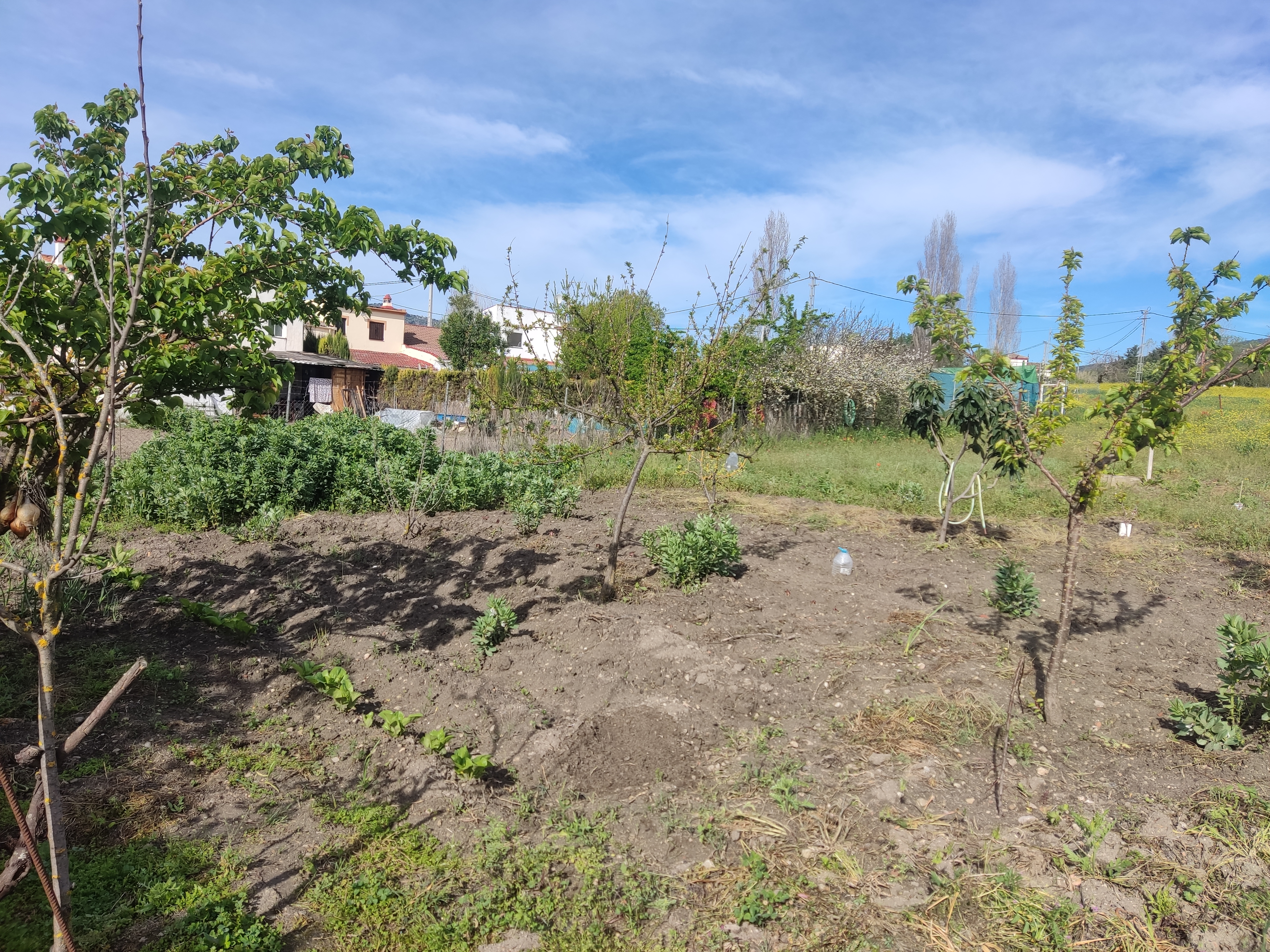 We also have a small orchard here with some 20 fruit trees and bushes ranging from almond, apple, apricot, blackberry, blackcurrant, cherry, gooseberry, lemon, mandarin orange, mirabelle, pear, plum, quince, raspberry (red and yellow varieties), redcurrant. We also have a small orchard here with some 20 fruit trees and bushes ranging from almond, apple, apricot, blackberry, blackcurrant, cherry, gooseberry, lemon, mandarin orange, mirabelle, pear, plum, quince, raspberry (red and yellow varieties), redcurrant.
Near the house I have reclaimed several areas of lawn which had little or no grass, added topsoil, free from a local restaurant, enriched the earth, and planted vegetables with varying degrees of success.
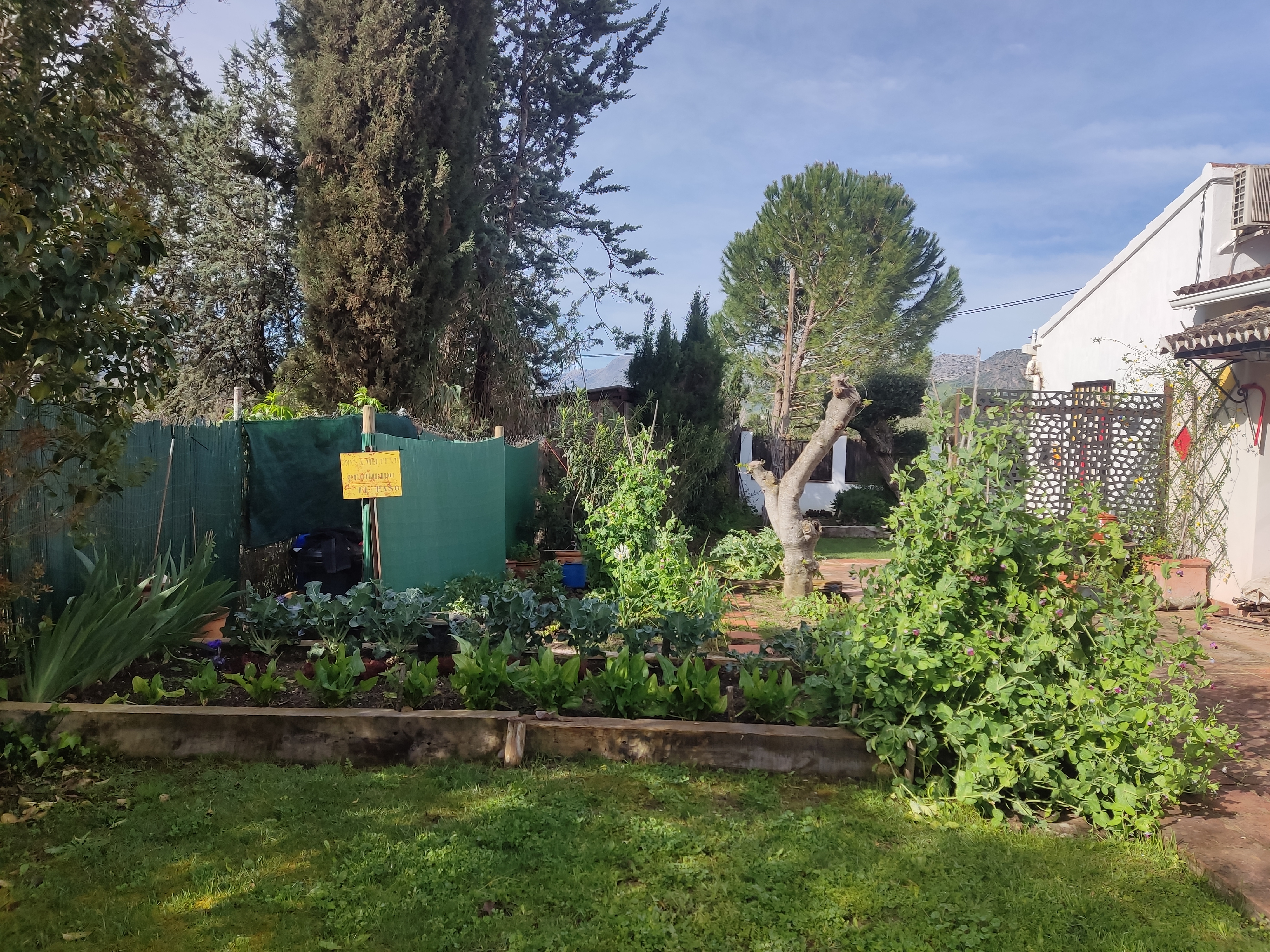 Tomatoes and runner beans have failed consistently, but this year I have a bumper crop of mangetout peas, several kinds of lettuce, onions and broccoli. The broad beans are looking promising and I’m still waiting for artichokes and brussels sprouts. Tomatoes and runner beans have failed consistently, but this year I have a bumper crop of mangetout peas, several kinds of lettuce, onions and broccoli. The broad beans are looking promising and I’m still waiting for artichokes and brussels sprouts.
It's only early April; too soon to plant potatoes, cucumbers and some other crops.
In addition, Rafael, a green-fingered Spanish guy if I ever I saw one, provides us with a supply of tomatoes, courgettes (green and yellow), cucumbers, squashes of various kinds, whatever he grows, throughout the summer.
Neighbours also occasionally give us produce.
No chickens
 Unlike Tom and Barbara Good we don’t keep chickens. Yet we get a regular supply of farm-fresh eggs from our next-door-but-one-neighbour Mercedes. Free-of-charge. We reckon it’s a kind of “rent” for the use of a corner of our field by her house, which she has turned into a huerto of her own. Unlike Tom and Barbara Good we don’t keep chickens. Yet we get a regular supply of farm-fresh eggs from our next-door-but-one-neighbour Mercedes. Free-of-charge. We reckon it’s a kind of “rent” for the use of a corner of our field by her house, which she has turned into a huerto of her own.
If her chickens aren’t laying we can buy eggs from another neighbour further up the lane, Pepi. Two euros for a dozen! Amazing! Her husband, Juan, already in his 80s, is also an industrial scale gardener and sporadically gives us produce such as cabbages and lettuce.
Photo: Britannica
Our good life
And just like the TV comedy, The Good Life, our situation is also a bundle of laughs.
Both long retired, we have the time, if not always the energy, to live this kind of good life. It's fairly inexpensive; we just need to pay for the odd packet of seeds or some seedlings, the occasional fruit tree and sacks of compost to augment my own two compost heaps (one aerobic and one anaerobic).
Most of our produce is free, or based on a kind of barter system.
Latest project
 An area in the back left corner of our garden has been a dumping ground for plant pots, reclaimed wood, eg pallets, rubble and goodness knows what. I am currently turning it into a "Secret Garden", a tidy sitting area with plants, shrubs and an almond tree. There are sunloungers, a sun umbrella and a table and chairs. Oh, and a barbecue. An area in the back left corner of our garden has been a dumping ground for plant pots, reclaimed wood, eg pallets, rubble and goodness knows what. I am currently turning it into a "Secret Garden", a tidy sitting area with plants, shrubs and an almond tree. There are sunloungers, a sun umbrella and a table and chairs. Oh, and a barbecue.
Located behind our pumphouse (for the well), and shaded from the next-door property by a hedge, it is very private.
There is also electricity available, for power tools and for lighting, should we wish to sit there in the late evening.
Conclusion
"The Good Life" English-style or our good life in Andalusia, well, it's all much the same, I reckon.
***
All photos by Paul Whitelock, unless otherwise indicated.
Interesting links:
Working for free? Why? Er… why not? - Secret Serrania de Ronda
Working for free? Why? Er… why not? Part 2. (eyeonspain.com)
© Pablo de Ronda
Acknowledgements:
A1 Inmobiliaria
Britannica
BBC
Eye on Spain
Karl Smallman
Paul Whitelock
Secret Serrania
Tags:
almond, almond tree, aloe vera, apple, apricot, BBC, Barbara Good, barbecue, barter system, blackberry, blackcurrant, bottle brushes, bougainvilleas, cabbages, cactus, cherry, climbers, compost, cherry trees, chickens, electricity, daisies, Eye on Spain, farm-fresh eggs, Felicity Kendall, fruit tree, Good, gooseberry, green-fingered, heather, hectare, honeysuckle, huerto, industrial scale gardener, Jerry Leadbetter, Juan, Karl Smallman, lemon, lettuce, lighting, mandarin orange, Margo Leadbetter, Mercedes, mirabelle, oleanders, orchard, Pablo de Ronda, pallets, Paul Eddington, pear, Penelope Keith, Pepi, Pfeifenputzer, plant pots, plants, plum, power tools, pumphouse, quince, Rafael, raspberry, redcurrant, Richard Briers, reclaimed wood, roses, rubble, "Secret Garden", Secret Serrania, seedlings, seeds, shrubs, sitting area, sunloungers, sun umbrella, The Good Life, Tom Good
 1
Like
Published at 11:48 AM Comments (0)
1
Like
Published at 11:48 AM Comments (0)
Spam post or Abuse? Please let us know
|
|